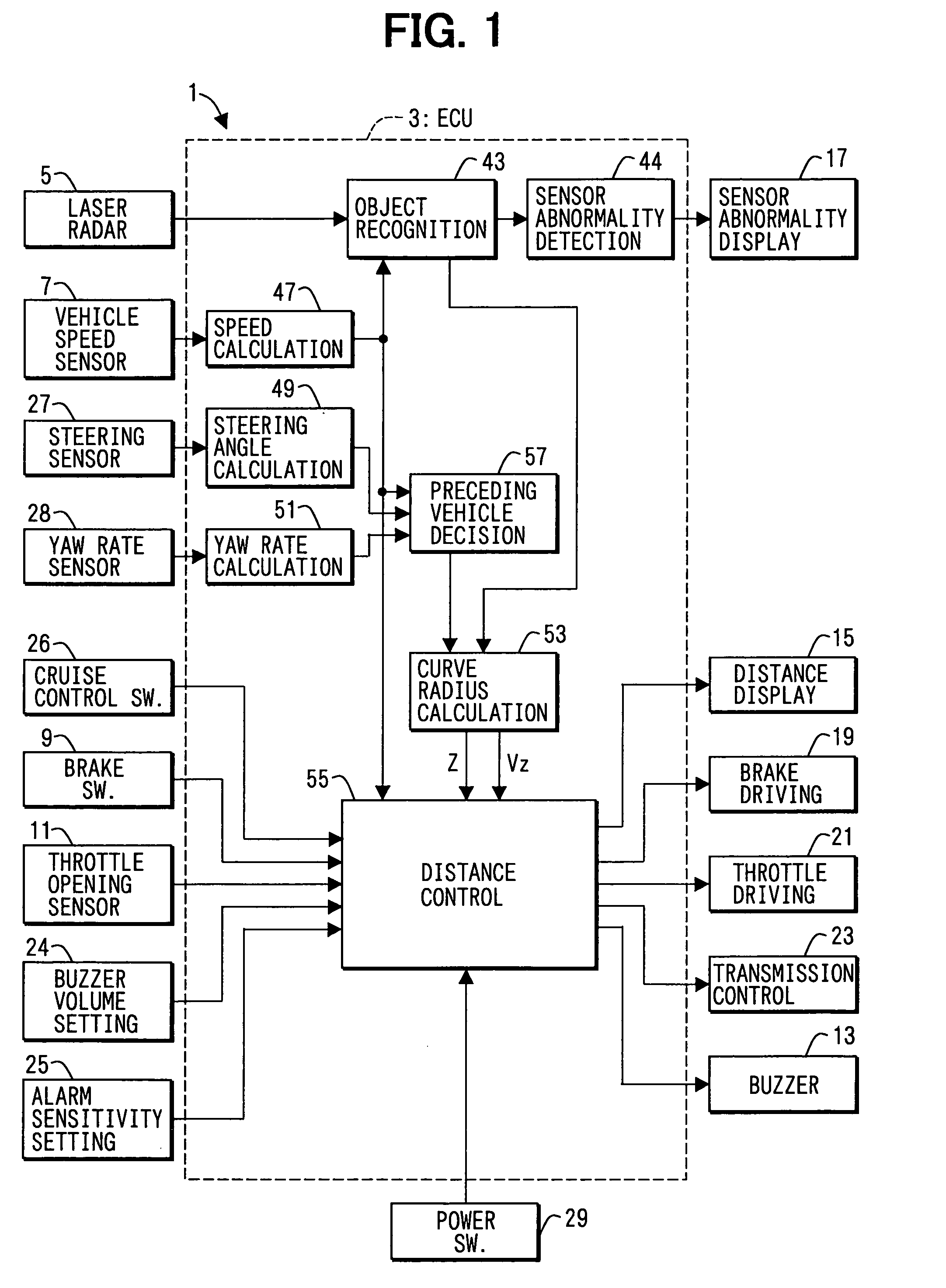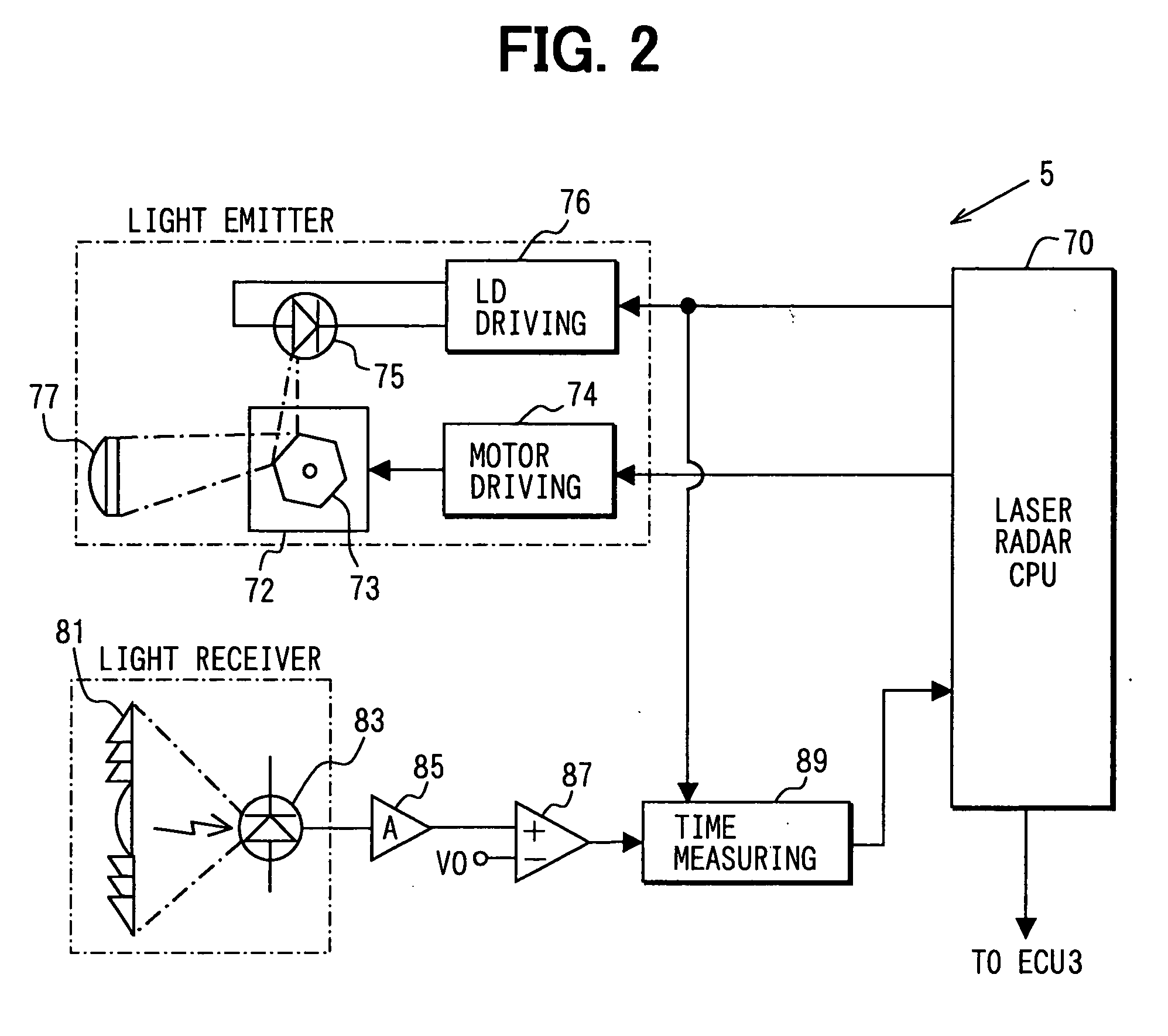Radar apparatus
a technology of radar and apparatus, applied in the field of radar equipment, can solve the problems of inaccurate reception time tp and large , achieve the effects of improving the accuracy of object detection, reducing and increasing the intensity of laser ligh
- Summary
- Abstract
- Description
- Claims
- Application Information
AI Technical Summary
Benefits of technology
Problems solved by technology
Method used
Image
Examples
first embodiment
[0028] A radar apparatus according to the first embodiment of the present invention is mounted in an inter-vehicle distance control system. The inter-vehicle distance control system controls a distance to a preceding vehicle at a desired distance and alarms when an obstacle exists in a predetermined area.
[0029] As shown in FIG. 1, an inter-vehicle distance control system 1 includes an electronic control unit (ECU) 3 as a main part. The ECU 3 includes a microcomputer, an input / output interface and the like.
[0030] The ECU 3 receives detection signals from a laser radar sensor 5, a vehicle speed sensor 7, a brake switch 9 and a throttle opening sensor 11. The ECU 3 outputs driving signals to an alarm buzzer 13, a distance display 15, a sensor abnormality display 17, a brake driving device 19, a throttle driving device 21 and an automatic transmission controller 23. The ECU 3 connects to a buzzer volume setting device 24 for setting volume of the alarm buzzer 13, an alarm sensitivity ...
second embodiment
[0083] In the first embodiment, the intensity of the laser lights is switched according to the speed of the vehicle. To the contrary, in the second embodiment, the intensity of the laser lights is switched according to a distance to a reflecting object.
[0084] In the second embodiment, the processing to recognize the object is attained as shown in FIG. 8. The laser lights are emitted at step S110. When step S110 is performed in the first repetition of the processing, the intensity of the laser lights is set to a default value. For example, the default value is set to be high to detect all of the reflecting objects in the measurement area 91. When step S110 is performed in the second repetition of the processing or later, the intensity of the laser lights is set to the intensity set at step S160 or S170 in the previous repetition.
[0085] When the reflected light is received, the laser radar CPU 70 of the laser radar sensor 5 reads the time point data every scanning line at step S120....
third embodiment
[0090] In the third embodiment, the intensity of the laser lights is switched according to the reflected light intensity data At of the scanning data.
[0091] In the third embodiment, the processing to recognize the object is attained as shown in FIG. 9. The laser lights are emitted at step S210. When step S210 is performed in the first repetition of the processing, the intensity of the laser lights is set to the default value. For example, the default value is set to be high similarly to the second embodiment. When step S210 is performed in the second repetition of the processing or later, the intensity of the laser lights is set to the intensity set at step S250 or S260 in the previous repetition.
[0092] When the reflected light is received, the laser radar CPU 70 of the laser radar sensor 5 reads the time point data every scanning line at step S220. At step S230, the distance data and the reflected light intensity data Δt are calculated from the read time point data. These calcula...
PUM
 Login to View More
Login to View More Abstract
Description
Claims
Application Information
 Login to View More
Login to View More - R&D
- Intellectual Property
- Life Sciences
- Materials
- Tech Scout
- Unparalleled Data Quality
- Higher Quality Content
- 60% Fewer Hallucinations
Browse by: Latest US Patents, China's latest patents, Technical Efficacy Thesaurus, Application Domain, Technology Topic, Popular Technical Reports.
© 2025 PatSnap. All rights reserved.Legal|Privacy policy|Modern Slavery Act Transparency Statement|Sitemap|About US| Contact US: help@patsnap.com



